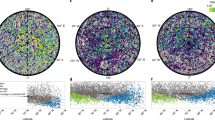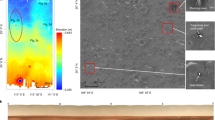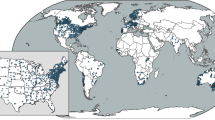Abstract
Multiple nations and private entities are pushing to make landing humans on Mars a reality. The majority of proposed mission architectures envision ‘living off the land’ by leveraging Martian water-ice deposits for fuel production and other purposes. Fortunately for mission designers, water ice exists on Mars in plentiful volumes. The challenge is isolating accessible ice deposits within regions that optimize other preferred landing-site conditions. Here we present the first results of the Mars Subsurface Water Ice Mapping (SWIM) project, which has the aim of searching for buried ice resources across the mid-latitudes. Through the integration of orbital datasets in concert with new data-processing techniques, the SWIM project assesses the likelihood of ice by quantifying the consistency of multiple, independent data sources with the presence of ice. Concentrating our efforts across the majority of the northern hemisphere, our composite ice-consistency maps indicate that the broad plains of Arcadia and the extensive glacial networks across Deuteronilus Mensae match the greatest number of remote-sensing criteria for accessible ice-rich, subsurface material situated equatorwards of the contemporary ice-stability zone.
This is a preview of subscription content, access via your institution
Access options
Access Nature and 54 other Nature Portfolio journals
Get Nature+, our best-value online-access subscription
$29.99 / 30 days
cancel any time
Subscribe to this journal
Receive 12 digital issues and online access to articles
$119.00 per year
only $9.92 per issue
Buy this article
- Purchase on Springer Link
- Instant access to full article PDF
Prices may be subject to local taxes which are calculated during checkout




Similar content being viewed by others
Data availability
The ice-consistency and thickness maps (as both GIS-compatible GeoTIFFs and browse images) along with the constituent data for each ice-detection technique are available on the SWIM project website at https://swim.psi.edu. All of the instrument datasets used to derive our ice-detection techniques are available on the NASA Planetary Data System at https://pds.nasa.gov/. The Dickson et al.24 Context Camera mosaic used to tabulate the geomorphology ice-consistency values can be found on the Caltech Murray Lab website at http://murray-lab.caltech.edu/CTX/index.html. Updates of new SWIM products can be found at https://twitter.com/RedPlanetSWIM.
References
Zubrin, R., Daker, D. & Gwynne, O. Mars direct: a simple, robust, and cost effective architecture for the Space Exploration Initiative. In Proc. 29th Aerospace Sciences Meeting AIAA-91–329 (AIAA, 1991).
Ash, R. L., Dowler, W. L. & Varsi, G. Feasibility of rocket propellant production on Mars. Acta Astronaut. 5, 705–724 (1978).
Baker, D. M. H. & Head, J. W. Extensive Middle Amazonian mantling of debris aprons and plains in Deuteronilus Mensae, Mars: implications for the record of mid-latitude glaciation. Icarus 260, 269–288 (2015).
Pathare, A. V., Feldman, W. C., Prettyman, T. H. & Maurice, S. Driven by excess? Climatic implications of new global mapping of near-surface water-equivalent hydrogen on Mars. Icarus 301, 97–116 (2018).
Piqueux, S. et al. Widespread shallow water ice on Mars at high latitudes and midlatitudes. Geophys. Res. Lett. 46, 14290–14298 (2019).
Leighton, R. B. & Murray, B. C. Behavior of carbon dioxide and other volatiles on Mars. Science 153, 136–144 (1966).
Paige, D. A. The thermal stability of near-surface ground ice on Mars. Nature 356, 43–45 (1992).
Mellon, M. T., Feldman, W. C. & Prettyman, T. H. The presence and stability of ground ice in the southern hemisphere of Mars. Icarus 169, 324–340 (2004).
Feldman, W. C. et al. Mars Odyssey neutron data: 2. Search for buried excess water ice deposits at nonpolar latitudes on Mars. J. Geophys. Res. 116, E11009 (2011).
Head, J. W., Mustard, J. F., Kreslavsky, M. A., Milliken, R. E. & Marchant, D. R. Recent ice ages on Mars. Nature 426, 797–802 (2003).
Squyres, S. W. The distribution of lobate debris aprons and similar flows on Mars. J. Geophys. Res. 84, 8087–8096 (1979).
Head, J. W. et al. Extensive valley glacier deposits in the northern mid-latitudes of Mars: evidence for Late Amazonian obliquity-driven climate change. Earth Planet. Sci. Lett. 241, 663–671 (2006).
Holt, J. W. et al. Radar sounding evidence for buried glaciers in the southern mid-latitudes of Mars. Science 322, 1235–1238 (2008).
Plaut, J. J. et al. Radar evidence for ice in lobate debris aprons in the mid-northern latitudes of Mars. Geophys. Res. Lett. 36, L02203 (2009).
Dundas, C. M. et al. Exposed subsurface ice sheets in the Martian mid-latitudes. Science 359, 199–201 (2018).
Byrne, S. et al. Distribution of mid-latitude ground ice on Mars from new impact craters. Science 325, 1674–1676 (2009).
Dundas, C. M. et al. HiRISE observations of new impact craters exposing Martian ground ice. J. Geophys. Res. 119, 109–127 (2014).
Milliken, R. E., Mustard, J. F. & Goldsby, D. L. Viscous flow features on the surface of Mars: observations from high-resolution Mars Orbiter Camera (MOC) images. J. Geophys. Res. Planets https://doi.org/10.1029/2002je002005 (2003).
Putzig, N. E. & Mellon, M. T. Apparent thermal inertia and the surface heterogeneity of Mars. Icarus 191, 68–94 (2007).
Bramson, A. M. et al. Widespread excess ice in Arcadia Planitia, Mars. Geophys. Res. Lett. 42, 6566–6574 (2015).
Feldman, W. C. et al. Global distribution of near-surface hydrogen on Mars. J. Geophys. Res. 109, E09006 (2004).
Mellon, M. T., Fergason, R. L. & Putzig, N. E. in The Martian Surface: Composition, Mineralogy, and Physical Properties (ed. Bell, J. F. III) 399–427 (Cambridge Univ. Press, 2008).
Putzig, N. E. et al. Thermal behavior and ice-table depth within the north polar erg of Mars. Icarus 230, 64–76 (2014).
Dickson, J. L., Kerber, L. A., Fassett, C. I. & Ehlmann, B. L. A global, blended CTX mosaic of Mars with vectorized seam mapping: a new mosaicking pipeline using principles of non-destructive image editing. In Proc. 49th Lunar and Planetary Science Conference abstr. 2480 (LPI, 2018).
Ramsdale, J. D. et al. Grid mapping the northern plains of Mars: geomorphological, radar, and water-equivalent hydrogen results from Arcadia Planitia. J. Geophys. Res. 124, 504–527 (2019).
Grima, C., Kofman, W., Hérique, A., Orosei, R. & Seu, R. Quantitative analysis of Mars surface radar reflectivity at 20 MHz. Icarus 220, 84–99 (2012).
Mouginot, J. et al. The 3–5 MHz global reflectivity map of Mars by MARSIS/Mars Express: implications for the current inventory of subsurface H2O. Icarus 210, 612–625 (2010).
Castaldo, L., Mège, D., Gurgurewicz, J., Orosei, R. & Alberti, G. Global permittivity mapping of the Martian surface from SHARAD. Earth Planet. Sci. Lett. 462, 55–65 (2017).
Campbell, B. A. et al. Roughness and near-surface density of Mars from SHARAD radar echoes. J. Geophys. Res. 118, 436–450 (2013).
MacGregor, J. A. et al. A synthesis of the basal thermal state of the Greenland Ice Sheet. J. Geophys. Res. Earth Surf. 121, 1328–1350 (2016).
Petersen, E. I., Holt, J. W. & Levy, J. S. High ice purity of Martian lobate debris aprons at the regional scale: evidence from an orbital radar sounding survey in Deuteronilus and Protonilus Mensae. Geophys. Res. Lett. 45, 11595–11604 (2018).
Baker, D. M. H. & Carter, L. M. Radar reflectors associated with an ice-rich mantle unit in Deuteronilus Mensae, Mars. In Proc. 48th Lunar and Planetary Science Conference abstr. 1575 (LPI, 2017).
Fuller, E. R. & Head, J. W. Olympus Mons, Mars: detection of extensive preaureole volcanism and implications for initial mantle plume behavior. Geology 31, 175–178 (2003).
Carter, L. M. et al. Dielectric properties of lava flows west of Ascraeus Mons, Mars. Geophys. Res. Lett. 36, L23204 (2009).
Simon, M. N., Carter, L. M., Campbell, B. A., Phillips, R. J. & Mattei, S. Studies of lava flows in the Tharsis region of Mars using SHARAD. J. Geophys. Res. 119, 2291–2299 (2014).
Campbell, B. A. & Morgan, G. A. Fine-scale layering of Mars polar deposits and signatures of ice content in nonpolar material from multiband SHARAD data processing. Geophys. Res. Lett. 45, 1759–1766 (2018).
Diniega, S. & Putzig, N. E. (chairs) MEPAG ICE-SAG Final Report from the Ice and Climate Evolution Science Analysis group (ICE-SAG) (MEPAG, 2019); http://mepag.jpl.nasa.gov/reports.cfm
Arvidson, R. et al. Mars Exploration Program 2007 Phoenix landing site selection and characteristics. J. Geophys. Res. 113, E00A03 (2008).
Golombek, M. et al. Selection of the Mars Science Laboratory landing site. Space Sci. Rev. 170, 641–737 (2012)
Novak, K. S., Liu, Y., Lee, C.-J. & Hendricks, S. Mars Science Laboratory Rover Actuator Thermal Design (AIAA, 2010); https://go.nature.com/3sHuGZz
Badescu, V. in Mars (ed. Badescu, V.) Ch. 2 (Springer, 2009).
Appelbaum, J. & Flood, D. J. Solar radiation on Mars. Sol. Energy 45, 353–363 (1990).
Golombek, M. et al. Selection of the InSight landing site. Space Sci. Rev. https://doi.org/10.1007/s11214-016-0321-9 (2016).
Acknowledgements
The Subsurface Water Ice Mapping (SWIM) in the northern hemisphere of Mars project outlined in this paper was supported by grants provided by NASA through the Jet Propulsion Laboratory (JPL subcontract number 1611855; JPL RSA: 1589197 and 1595721). Elements of the ice-detection techniques were pioneered through support provided to team members by the NASA Mars Reconnaissance Orbiter Project. The PSI also acknowledges SeisWare International Inc. for an academic license of their software that was used for the SHARAD subsurface mapping. Any use of trade, firm or product names is for descriptive purposes only and does not imply endorsement by the US Government.
Author information
Authors and Affiliations
Contributions
G.A.M. and N.E.P. led the project and wrote the majority of the manuscript. N.E.P., H.G.S., R.H.H., Z.M.B. and M.R.P. conducted the thermal analysis. A.M.B., E.I.P., Z.M.B., M.M. and M.R.P. undertook the radar subsurface dielectric mapping and analysis. D.M.H.B. led the geomorphic mapping. G.A.M. and B.A.C. derived the radar surface analysis products. M.R.P. set up the computational and website infrastructure and archiving. M.R.P., Z.M.B. and G.A.M. were responsible for producing the integrated Ci products. A.P., C.M.D., I.B.S. and B.A.C. contributed to the broad analysis and assisted the other team members in the preparation of the manuscript.
Corresponding author
Ethics declarations
Competing interests
The authors declare no competing interests.
Additional information
Peer review information Nature Astronomy thanks Hideaki Miyamoto, Reid Parsons and the other, anonymous, reviewer(s) for their contribution to the peer review of this work.
Publisher’s note Springer Nature remains neutral with regard to jurisdictional claims in published maps and institutional affiliations.
Supplementary information
Supplementary Information
Supplementary Discussion, Figs. 1–4, and Tables 1 and 2.
Rights and permissions
About this article
Cite this article
Morgan, G.A., Putzig, N.E., Perry, M.R. et al. Availability of subsurface water-ice resources in the northern mid-latitudes of Mars. Nat Astron 5, 230–236 (2021). https://doi.org/10.1038/s41550-020-01290-z
Received:
Accepted:
Published:
Issue Date:
DOI: https://doi.org/10.1038/s41550-020-01290-z
This article is cited by
-
Water Ice and Possible Habitability in the Landing Area of Tianwen-1 Mission
Space Science Reviews (2024)
-
Layered subsurface in Utopia Basin of Mars revealed by Zhurong rover radar
Nature (2022)
-
Sequential Value of Information for Subsurface Exploration Drilling
Natural Resources Research (2022)
-
North polar trough formation due to in-situ erosion as a source of young ice in mid-latitudinal mantles on Mars
Scientific Reports (2021)



